Key Takeaways
➡️ Hiring the right employee starts with creating the right JD and job add.
➡️ HR Recruiters must post job ads to the right platforms, targeting the right applicants.
➡️ The application form and interview questions, whether online or in person, should easy for the candidates to understand, yet good enough to evaluate their knowledge, skills, and abilities.
➡️ Shortlisted candidates must be background checked and assessed on their job-related skills and abilities.
➡️ The candidate who is finally selected must be negotiated appropriately and placed accordingly.
➡️ Following hiring, the onboarding process must be made smooth.
➡️ Throughout the process, HR recruiters must utilized the right tools and methods for best results.
Employers are always seeking resources that help them reduce costs and increase revenues. And for growing businesses looking to scale and expand their business, hiring employees appropriately might be a bit of a task. Especially if you need to give more time to running the business and developing its strategies.
Many startups, SMEs, or small teams sweat over how to hire employees effectively. Because a bad hire could lead to devastating losses. More than a good hire improving your ROI.
According to the Recruitment and Employment Confederation (REC), a bad hire can reduce team productivity by up to 40%! So, to counter such losses, you must know how to hire employees effectively and efficiently.
What is the Hiring Process?
A typical hiring process begins with submitting a requisition for filling a vacancy or replacing an existing employee. And it ends with the new hire joining the organization.
Hiring is broken down into two major parts: recruitment and selection. Recruitment is the process of attracting the right candidates. Selection, on the other hand, involves choosing the right candidates and eliminating the less competent ones from the pool, eventually filling the vacant position.
To recruit the right candidates, you have to screen, sort, and shortlist the right ones. Once you have the right pool, you can select the new hire by interviewing, testing, background checking, and signing relevant hiring documents.
PLEASE NOTE: Many practitioners use the term recruitment to mean BOTH recruitment and selection or the whole hiring process.
Internal vs External Recruitment
There are two types of recruitment you can implement for your growing company: internal and external recruitment.
Internal recruitment is the process of filling positions with existing employees within the organization. Whereas, external recruitment refers to hiring resources outside of a company for new vacancies.
Internal recruitment occurs through promotions, job transfers, succession planning, and employee training and development. External recruitment, on the other hand, takes place through the steps that we will explain next.
What are the major steps in the recruitment process?
As stated above, we are explaining the steps of an external recruitment process.
For any recruitment to initiate, some kind of need or gap has to occur. And when you are recruiting externally, at least one of the following things happened:
- An existing employee left or served notice
- An employee is underperforming consistently and needs to be replaced
- A new role has emerged
- There is too much workload on the existing employees
- You plan to expand your operations or business.
- A newly vacated position can’t be filled by any existing employee.
If any or more of the above factors occur, you need to initiate a recruitment process, starting with a manpower requisition.
Manpower Requisition
The first step that an HR person needs to take is to fill out a manpower requisition form. Or, they may email the concerned authority, requesting manpower recruitment, in consultation with the department of the vacated position.
The communication should include:
- Position and designation
- No. of manpower needed
- Expected date of job posting
- Expected date of recruitment commencement
- Time to fill the position
- Brief Job Responsibilities
- Qualification Specifications of the Candidate
- Expected Date of Joining of the Hire(s)
- Proposed salary or wage for the position
- Proposed total budget for the hiring process
If you are the employer carrying out recruitment yourself, you don’t need to submit any requisition. Just keep a record of the manpower requirement and analyze the budget for hiring.
Job Description Drafting
If it’s an existing role that you are trying to fill, then most probably the job description (JD) is already in place and you just need to make some small edits when recruiting someone new. However, for a completely new position, you need to do a job analysis and craft a compelling and comprehensive JD. To boost and speed up your writing, you can take help of an AI tool like GetGenie to draft the JD.
| As per SHRM: “Job analysis is the process of studying a job to determine which activities and responsibilities it includes, its relative importance to other jobs, the qualifications necessary for the performance of the job, and the conditions under which the work is performed.” |
A job description is a thorough documentation of the
- Scope of work,
- duties,
- tasks,
- responsibilities
- working conditions
- Reporting
- skills and qualifications
that an individual applying for the job needs to possess to perform successfully in the role.
Selecting the Source and Platform for Job Vacancy
Next, you need to decide how you will source applications.
You can source candidates via:
- Job boards like Indeed or Monster: platforms where multiple jobs are posted online from various employers. Depending on the platform’s pricing, it may be affordable for you.
- Social media like LinkedIn or Facebook: good way for startups to post jobs, free of costs.
- Internal References through team members or colleagues: You can talk to your other team members about referring to skilled and/or experienced individuals.
- Job fairs at state, institutional, local, or national level: there are events held in universities or local arenas, sponsored by universities for graduates, or organized by HR firms with multiple clients. Could be a good source to acquire fresh talents; however getting into the job fair might not be easy without networking or brand value.
- Stored applications in CV banks: if you already collected CVs in your website or official emails.
- Applicant Tracking Systems (ATS): HR tools specialized in collecting CVs and sorting candidates as per requirements. Usually expensive for growing firms.
Once you’ve selected the platform or system through which you will source applications, it’s time to create the job advertisement and post it accordingly.
Job Advertisement Drafting & Posting
When drafting the job advertisement, you should keep it aligned with the JD and make sure your target applicants understand the job requirements and responsibilities. The trick is to make sure you have the right keywords in your ad so that the right applicants can search for the job post accordingly.
Using tools like Yosuite can help you with this. Yosuite lets you directly draft JDs and Application Forms on its platform.
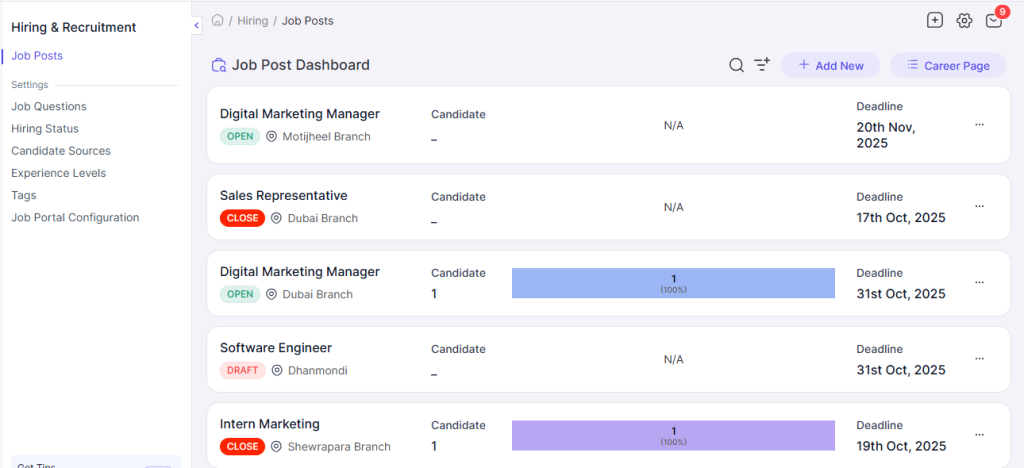
When you click on Add New in the Hiring and Recruitment module of Yosuite, it will take you to the Job Details page. There, you can input the job title, department, location, job requirements, job duties, educational qualifications, perks & benefits, etc.
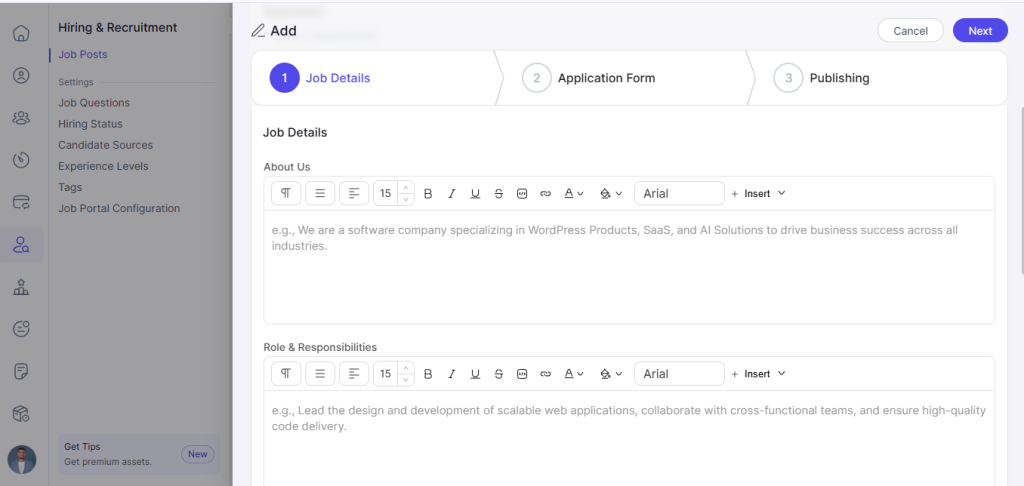
Once you are done with filling the details of the Job ad, you can move to filling the Application Form details.
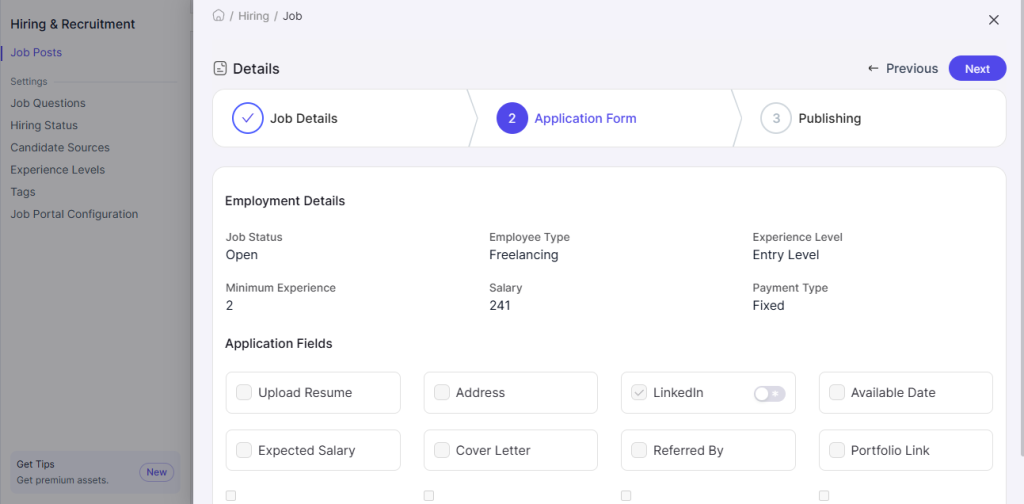
Here, you can add the job status, employee type, employee level, salary, etc. And then finally publish the job ad with the relevant details and timeline.
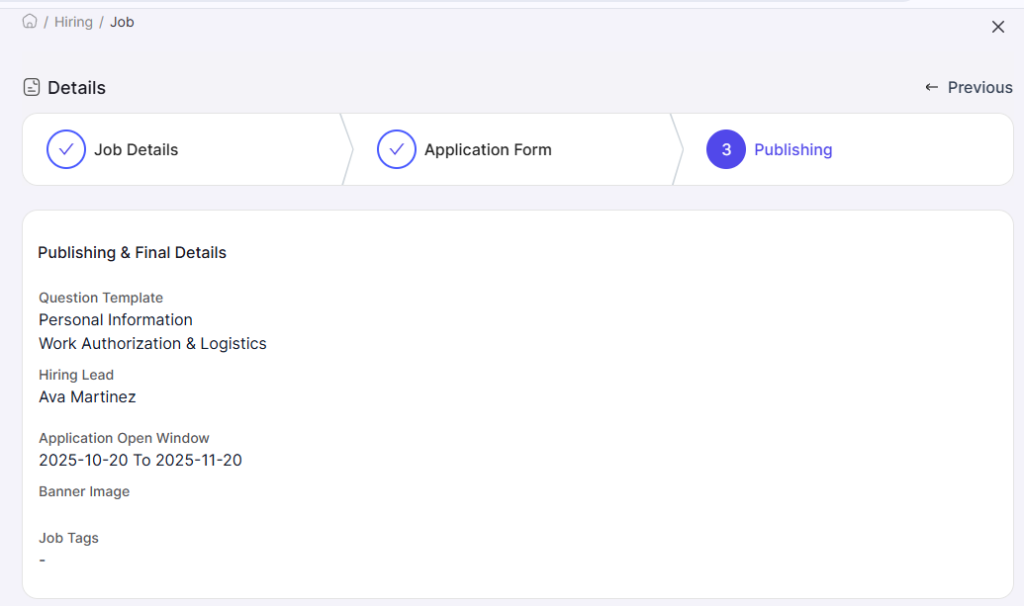
Collection of Applications
Once you’ve posted the jobs on appropriate platforms or visited job fairs or events, you can now collect the CVs/Resumes with other relevant documents (if you require them) in the CV boxes, emails, or ATS storages. Depending on the type of role or position you advertised, and the source of collection, the number of applications could be only a handful or come in thousands.
For instance, asking your peers or colleagues to refer some CVs for a managerial position may yield you 20 or 30 applications. Posting a job on a job board like Indeed for the position of a Sales Officer might get you over a thousand applications.
CV Sorting
Now that you have the applications in hand, you need to sort out the CVs for the right candidates. Remember, there may be a vast number of applications that do not meet your job requirements. So, you need to thoroughly check and eliminate those applications to create the right candidate pool to carry out preliminary screenings and eventual selections.
Shortlisting
Shortlisting happens at various stages of the recruitment and selection process. However, the first time it is done is when you select the right candidates from the countless applications and book them for interviews or screenings.
The HR manager or assigned personnel from the HR team needs to create a candidate information form/sheet that summarizes the credentials of the shortlisted ones for the interview. It should preferably include bullet points of the candidate’s work experiences, educational qualifications, skills, training, and personal information like address, contact number, etc.
Once that is completed and the candidates are communicated about their assessments/interviews via emails or phone calls, recruitment gives way to the selection process.
From Recruitment to the Selection Process
Before we explain the Selection process and what it is, please note that many practitioners use the term recruitment to mean BOTH recruitment and selection or the whole hiring process. However, if you are someone working in HR, you should know the differences, especially the different steps in both these hiring processes.
In simple terms, Selection is the process of choosing the right candidates and eliminating the less competent candidates from a pool of candidates/applicants to eventually fill the vacant position(s). Let’s now look at the selection process.
1. Preliminary Interview/Assessment
Preliminary interviews are the very first and typically short interviews or assessments in the hiring process. These are treated as a screening process. Employers usually reject candidates that do not fit the company’s needs and job requirements during this phase of selection.
One option that many employers, especially MNCs and large enterprises go for, is the online testing rounds. Here, if an applicant’s resume matches the job requirements, they will be asked to take online tests or assessments. These assessments evaluate the candidate’s basic intelligence and aptitudes.
Another option is directly talking over a phone call or online video call to understand the candidates’ basic knowledge and experience relevant to the role.
Also, some employers go for direct, short, offline interviews that last a maximum of 20 minutes. Usually, many candidates visit the office in slots and the interview sessions take place throughout the day.
2. Interview Rounds
Once the preliminary assessments are completed, the shortlisted candidates now come face to face in interview sessions with the recruitment team and the concerned department personnel, especially the manager.
In this phase, the interviewees are questioned in-depth about the subject matter, their previous experiences relevant to the role, their skills, and anything related to the role that may be deemed beneficial or vital.
For instance, the interviewer may throw a verbal case study to the candidate to respond. Through this, their critical thinking skills related to the role can be assessed. Many times, the interviewer might intentionally put the candidates in uncomfortable or difficult situations to test how well they can tackle the situation. Handling the situation could be a good indicator of their performance when hired.
3. Pre-Final Selection
Once all the testing, interviews, and assessments are completed, the HR manager in consultation with the Department Head should now be able to find at least one suitable and competent candidate for the role. If they find more than one who are good fit for the role, then the HR team can rank them according to their tests and interview results.
This step will help to ensure backup candidates for onboarding in case the top candidate does not accept the offer or fails to pass reference and fitness checks (if any).
So, once a candidate among the lot is finally selected for the role, the final negotiation round comes with the HR manager, who negotiates as per company policy. The HR manager may directly have a face-to-face conversation with the top candidate regarding his/her offer salary and other benefits, or it may be done over a phone/online call.
4. Medical/Fitness Tests
Various roles require fitness and medical tests because the role demands so. For instance, a production engineer at a factory premise, a food delivery rider, or roles where the candidate has to go through a lot of travel or physical labor.
Also, if a potential hire has certain conditions like asthma or chronic migraine, he/she may not be placed on premises where lots of dust or particles circulate, like garment industries.
5. Background/Reference Checks
Now this particular phase could be a make or break for the whole hiring process. This is the phase that requires candidates NOT to burn bridges with their previous employers. Because here, the HR personnel contact the candidate’s previous manager or the point of contact in the organization he/she is leaving.
Authorized HR personnel may contact the candidate’s reporting manager or HR manager from the leaving/previous company. This check is done to confirm that the candidate worked with the organization with the tenure mentioned by the candidate. Also, they may want to learn about the candidate’s demeanor and performance with the company.
Any negative feedback here might adversely impact his/her selection.
6. Selection Decision
If the final selection passes all the phases of the recruitment and selection process and agrees to the offered position and salary, the candidate will now be onboarded.
As the top candidate is finally selected, the HR department must draft his/her contract letter and ensure the right materials and equipment are in place to accommodate the new hire into the team.
Ensuring proper employee onboarding steps
When the employer and the new hire are on the same page, the hiring process gives way to the onboarding process.
Job Offer and Acceptance
The first step the employer takes in ensuring employment with the new hire is by extending an offer letter and getting an acceptance letter for the job offer. Once this move is taken care of, the HR personnel ask for copies of relevant documents of the new hire. These documents are related to his/her work experience, education, TIN, NID, skills, training, etc.
In many countries, a new hire has to submit particular forms during joining.
Socialization/Orientation
When the documentary formalities are done and the employee is ready to join and commence work, the assigned HR personnel introduces him to the team members and other employees as well. He/she is given a copy of the employee handbook or COC.
An induction ceremony or orientation program is arranged that includes all recruits of the past month or so to acquaint them with the ways of the company and their departmental tasks.
Managing the New Hire’s Setup
For offices that require employees to work from the office, getting their seat arrangements is paramount. They should have their needed devices and furniture ready for work, along with stationery or utensils.
Distribution of COC/Employee Handbook
This important step ideally occurs during the orientation program. However, it may be sent via email during the 1st week of joining and explained thoroughly by HR. The authorized HR personnel should thoroughly explain the Code of Conduct (COC) to the new hire so that they don’t deviate from it.
Handing over of Responsibilities/JD
Finally, when all is said and done, the new hire should be handed over his/her JD, with a signed copy to HR. And the personnel the new hire will be replacing should hand over the tasks in due time. Before their notice period is over. However, if there is no person currently working in the position, the department head should make sure the new hire knows his/her duties and responsibilities.
The new hire is ready to carry out his/her duties.
Effective hiring methods and tools
We mentioned above some hiring methods and ways that HR managers can leverage to get the optimum recruitment results. Now, we will look at them in detail.
HR Software Solution
One of the most popular tools in modern recruitment is HR software solution. These solutions offer comprehensive systems that handle everything from applicant tracking to onboarding. HR professionals can automate repetitive tasks like resume screening and interview scheduling.This helps them free up time to focus on more strategic activities.
For instance, in a software solution like BambooHR, you integrate job openings into the system via LinkedIn or Indeed job boards.
Moreover, these solutions offer data analytics, which provide valuable insights used to refine and optimize hiring strategies. This helps organizations can make more informed decisions and improve the overall efficiency of their recruitment efforts.
Online Tests and Interviews
Another critical component of effective hiring is the use of online tests and interviews. The digital transformation has made it possible for companies to reach a wider pool of candidates and evaluate them remotely. Online assessments allow recruiters to screen candidates for specific skills and competencies before inviting them for interviews. This not only saves time but also ensures that only the most qualified candidates proceed to the next stage.
Virtual interviews, on the other hand, offer flexibility for both candidates and recruiters, enabling interviews to be conducted from anywhere in the world. This method is particularly beneficial in today’s globalized workforce, where talent can be found across different geographies.
Group Assessments
Group assessments are another valuable tool in the hiring process. These assessments involve placing candidates in a group setting to observe how they interact with others and handle collaborative tasks. Group assessments provide a unique opportunity to evaluate candidates’ communication skills, teamwork abilities, and how they perform under pressure.
This method is particularly useful for roles that require strong interpersonal skills and the ability to work well in a team environment. By observing candidates in a group context, recruiters can gain a more comprehensive understanding of their potential fit within the organization.
Personality Tests
Personality tests are a popular tool for evaluating candidates. Personality tests can provide insights into a candidate’s potential job performance, work style, and how they might interact with existing team members.
Some well-known examples of personality tests include:
- Myers-Briggs Type Indicator (MBTI): Assesses personality based on four dichotomies (e.g., Introversion vs. Extraversion) to categorize individuals into one of 16 personality types.
- Hogan Personality Inventory (HPI): Designed to assess normal personality characteristics that influence job performance and interpersonal relationships.
- Big Five Personality Traits (OCEAN): Measures five broad dimensions of personality: Openness, Conscientiousness, Extraversion, Agreeableness, and Neuroticism.
- HEXACO Personality Inventory: Similar to the Big Five, but adds a sixth dimension called Honesty-Humility.
- Caliper Profile: Measures personality traits and how they relate to job performance, often used in pre-employment assessments.
These assessments help organizations make more informed decisions about which candidates are likely to thrive in their work environment and contribute positively to the company’s culture.
Aptitude Tests
Aptitude tests are another effective method for assessing candidates’ suitability for a role. These tests measure cognitive abilities, problem-solving skills, and the capacity to learn new tasks. Aptitude tests are particularly useful for identifying candidates who have the potential to grow and develop within the company, even if they lack specific experience in the role.
By utilizing these tests, organizations can build a workforce that is resilient and capable of meeting future challenges. Examples include numeric reasoning, verbal reasoning, inductive reasoning, and other types of tests.
Social Media Checks
Social media checks have also become an integral part of the hiring process. By reviewing candidates’ social media profiles, recruiters can gain additional insights into their personalities, values, and online behavior. Social media checks can reveal information that might not be apparent from a resume or interview, helping recruiters make more informed decisions.
However, organizations need to conduct these checks ethically and ensure that they do not infringe on candidates’ privacy rights.
Obstacles in the Hiring Process to Look Out
Because the hiring process is critical work, HR professionals need to be careful against any pitfalls that may occur in carrying out this process. So, let’s look at some challenges and obstacles that you need to be aware about:
Background checks may be flawed.
Errors in background checks can occur due to outdated or incorrect information, issues with data accuracy, or even cases of mistaken identity. In some instances, candidates may be unfairly disqualified based on incomplete or incorrect records.
To mitigate this risk, employers must ensure they are using reputable background check services, double-check the information for accuracy, and provide candidates with an opportunity to address any discrepancies.
Insufficient document submissions
Another common obstacle in the hiring process is the submission of insufficient or incomplete documents by candidates. Essential documents, such as educational certificates, work experience records, and identification proofs, are crucial for verifying a candidate’s qualifications and eligibility. When candidates fail to provide all necessary documents, it can delay the hiring process or, worse, result in hiring someone who does not meet the job’s qualifications.
Issues with legal compliance
Failure to adhere to relevant laws and regulations can have serious consequences for an organization. Issues such as non-compliance with equal employment opportunity laws, improper handling of candidate data, and failure to obtain necessary work permits can all lead to legal challenges. Additionally, organizations must be aware of labor laws, anti-discrimination policies, and privacy regulations that vary by region.
False Positive Recruitment
False positive recruitment occurs when a candidate appears to be the perfect fit based on their resume and interview performance, but later proves to be unsuitable for the role. This can happen for various reasons, such as candidates exaggerating their skills or experience, interviewers being swayed by a candidate’s charisma or insufficient testing of a candidate’s actual abilities.
To minimize the risk of false positives, employers should use comprehensive assessment methods, including practical skills tests, personality assessments, and multiple interview stages with diverse panels, along with accurate background checks.
Final Negotiations may not work out right
If the expectations of the employer and the candidate are not aligned, negotiations can break down, leading to the loss of a promising candidate. Issues can arise if the offered compensation does not meet the candidate’s expectations if there is a lack of flexibility in work arrangements, or if there is a mismatch in the perceived value of benefits.
To avoid these situations, employers should engage in open and transparent communication throughout the hiring process, understand the candidate’s priorities, and be prepared to make reasonable concessions where possible.
Hiring Metrics
Finally, tracking and analyzing hiring metrics is essential for continuously improving the recruitment process. These metrics provide valuable feedback that can be used to refine hiring strategies. By monitoring these metrics, organizations can identify areas for improvement and make data-driven decisions that enhance the effectiveness of their recruitment efforts.
Some of the top hiring metrics include:
- Cost per hire
- Time to hire
- Quality of hire
- Candidates per hire
- Candidate callback rate
- Retention rate
- Candidate job satisfaction
- Application completion rate
- Adverse impact
- Recruitment ROI
Final Words
Hiring is more than just a process of filling vacancies; it’s a strategic move that defines the trajectory of your organization. Each employee you select contributes to the company’s culture, operational efficiency, and overall success. The focus should not only be on skill alignment but also on uncovering potential and ensuring a cultural fit.
Embracing diversity and leveraging advanced assessment tools are essential to building a team that not only meets current demands but also drives future growth.


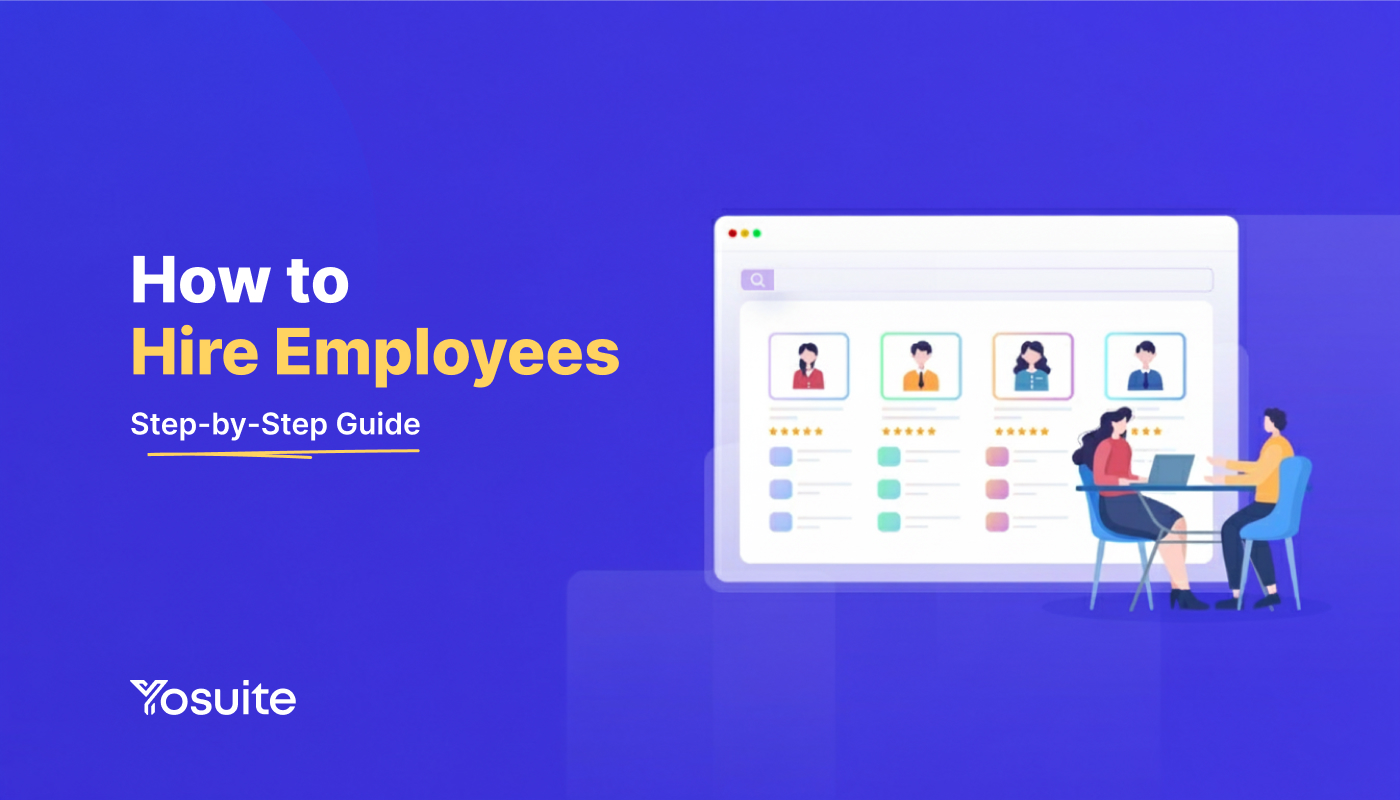
Leave a Reply